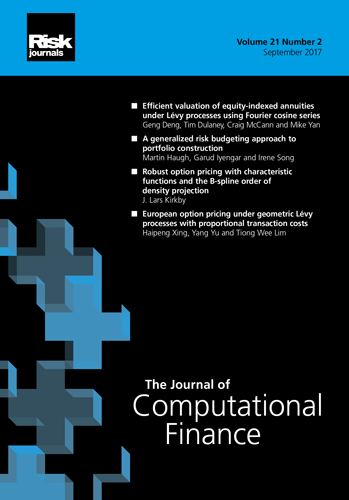
Published by: Infopro Digital Risk
Editor(s): Christoph Reisinger, University of Oxford
The Journal of Computational Finance is an international peer-reviewed journal dedicated to advancing knowledge in the area of financial mathematics. The journal is focused on the measurement, management and analysis of financial risk, and provides detailed insight into numerical and computational techniques in the pricing, hedging and risk management of financial instruments. The journal welcomes papers dealing with innovative computational techniques in the following areas:
Individual RSS Feed not available. All content aggregated into primary Risk.net RSS Feed.
- An entropy-based class of moving averages
- Tracking toxicity in fast and complex markets
- Volatility-sensitive Bayesian estimation of portfolio value-at-risk and conditional value-at-risk
- Does investors’ sentiment influence stock market volatility? Evidence from India during pre- and post-Covid-19 periods
- The impact of economic sentiment on financial portfolios during the recent turmoil
- Luxury watches: a viable alternative investment or mere speculative trend? An analysis of two decades before the pandemic
- A multidimensional transform for pricing American options under stochastic volatility models
- A simple local correlation model
- An equity-implied rating model for unrated firms
- Optimal time-consistent reinsurance and investment strategies for multiple dependent types of insurance business and a unified investment framework
- Examining sustainability investments and financial performance of football clubs: an empirical analysis
- Revenue analysis of spot and forward solar energy sales in Texas
- Key indicators for the credit risk evaluation of clients and their changing characteristics
- Securities and Exchange Commission Form 13F Holdings Report: statistical investigation of trading imbalances and profitability analysis
- Design risk: the curse of constant proportion portfolio insurance
- A study of China’s financial market risks in the context of Covid-19, based on a rolling generalized autoregressive score model using the asymmetric Laplace distribution
- The impact of greenhouse gas aversion on optimal portfolios
- Just solve it: a simple method to improve the design and performance of liquidity-saving mechanisms
- Alternative margin models for mortgage-backed securities
- Financial distress prediction with optimal decision trees based on the optimal sampling probability
- Centralized and decentralized payments networks: a simple cost comparison
- Quantifying credit portfolio sensitivity to asset correlations with interpretable generative neural networks
- Default prediction based on a locally weighted dynamic ensemble model for imbalanced data
- How do credit rating agencies and bond investors react to credit guarantees? Evidence from China’s municipal corporate bond market
- Credit risk management: a systematic literature review and bibliometric analysis
- Characteristics of student loan credit recovery: evidence from a micro-level data set
- Volatility spillover effects and risk assessment of Indian green stocks: a DCC-GARCH analysis
- Renewable energy generation capacity following the Russian invasion of Ukraine, and the stock market performance of energy firms: evidence from southern European Union countries
- Composite Tukey-type distributions with application to operational risk management
- Semi-nonparametric estimation of operational risk capital with extreme loss events
- New proxy schemes for swing contracts
- The important role of information technology and internal auditing in risk management: evidence from Greece
- Estimating the probability of insurance recovery in operational risk
- Banking competition and systemic risk: evidence from China
- Better anti-procyclicality? From a critical assessment of anti-procyclicality tools to regulatory recommendations
- Assessing the potential profitability of automated power market trading using event signals sourced from grid frequency data
- Multi-factor default correlation model estimation: enhancement with bootstrapping
- Are cryptocurrencies cryptic or a source of arbitrage? A genetic algorithm approach
- Gas market area mergers: when is bigger better?
- The impact of the Fundamental Review of the Trading Book: evaluation on a stylized portfolio
- On the recovery tools of a central counterparty
- The trade-off between shorter settlement times and multilateral netting benefits in deferred net settlement
- On the contagion effect between crude oil and agricultural commodity markets: a dynamic conditional correlation and spectral analysis
- Evaluating credit valuation adjustment with wrong-way risk for Bermudan options
- Shapley values as an interpretability technique in credit scoring
- Optimal damping with a hierarchical adaptive quadrature for efficient Fourier pricing of multi-asset options in Lévy models
- Extremiles, quantiles and expectiles in the tails
- Assessing the potential for asset diversification: an analysis of Brazilian stock indexes, Bitcoin, gold, crude oil and exchange rates
- Forecasting the default risk of Chinese listed companies using a gradient-boosted decision tree based on the undersampling technique
- Conditional and unconditional intraday value-at-risk models: an application to high-frequency tick-by-tick exchange-traded fund data
No Journal Account Available. Publisher Only.
